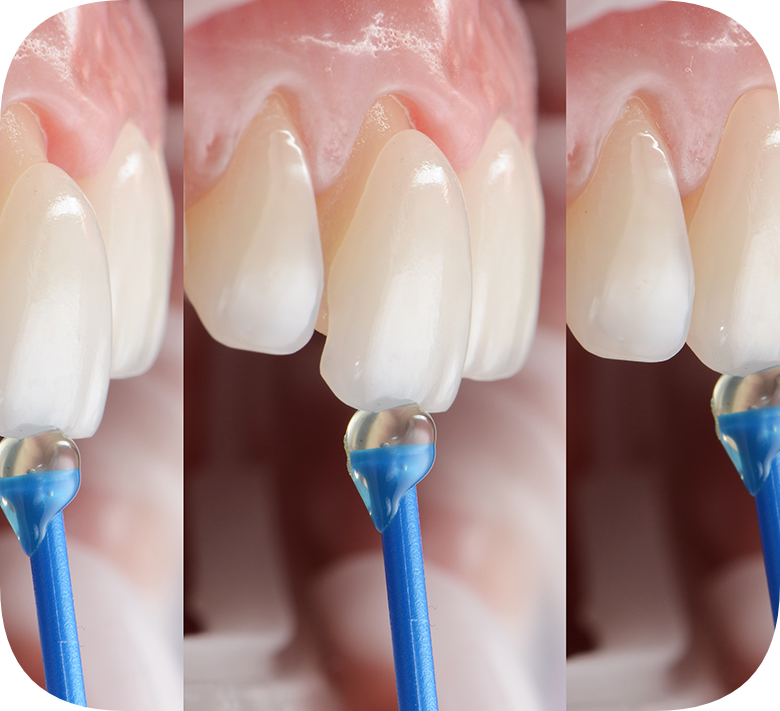DENTOMED TRABZON DENTISTRY
What is porcelain laminate?
Lamina means leaf in Latin. The anterior surfaces of the teeth are abraded by 0.3-0.7 mm and porcelain lamina is adhered. In this way, the loss of healthy tooth tissue is minimized.
When is porcelain laminate applied?
Porcelain lamina can be used in case of discoloration for which bleaching does not work, on teeth with structural defects, in cases such as old filling restorations. Since the lamina will be damaged in cases such as nail biting and pencil biting, it is not recommended to apply the lamina before solving the existing problems in case of such habits or if there is severe gingival recession.
How many sessions are applied in the porcelain lamina treatment?
It is usually completed in 2-3 sessions. This takes about 1 week.
FAQ
Frequently asked questions about Laminate Veneer treatment
What does a laminate veneer mean?
It is a technique used to permanently change the shape and colour of teeth. Laminate veneer is a very thin, shiny, smooth porcelain plate which suits the shape and colour of other teeth, gums, and lips, and guarantees a natural smile to the patient. Laminates prepared in a laboratory environment are then attached to the front surface of the tooth by a dentist.
When are the laminate veneers used?
• Closing the diastemas, lengthening the teeth and reshaping them if necessary
• As a treatment of broken or cracked teeth
• As a solution for patients who do not like the colour of their teeth discoloured by antibiotics and desire a permanent whiteness
• In patients who do not like their own smile, as a part of smile design
• Porcelain veneers can be an alternative treatment for slightly crooked teeth
How many times should I visit the dentist in order to get the porcelain veneers?
Laminate veneer treatment takes at least two sessions. The length of a particular session may vary due to the state of the teeth and the number of veneers to be prepared and attached.
If there is any need for procedures improving the aesthetics of gums, first the gum treatments should be performed. Only then the laminate treatment should take place.
Will I feel pain while undergoing a laminate veneer treatment?
No pain is inflicted during the procedure. However, in some cases, local anaesthesia may be applied to avoid the possibility of pain. After the first session, temporary laminates are attached in order to protect the teeth until the permanent veneers attachment. Therefore, the patient, not to mention that the issue of tooth sensitivity is avoided, experiences no esthetic problem.
How does the laminate veneer process look like?
In the first session, the tooth surface is prepared to later attach the laminates. 0.3-1 mm of the surface is removed from the surface and the measure is taken.
Using this measure, very thin porcelain laminates of suitable colour and form which will complete a beautiful smile are prepared. Finally, they are attached using a special glue which fits the colour of the tooth.
How can I get to know beforehand how the porcelain laminates will look like?
During the first visit to the doctor’s office measurements are taken from the patient’s mouth. Using the acquired tooth model a mock-up model is prepared in the laboratory using a special material. In this way, doctor and patient, using a 3D model, can make changes according to their wishes and decide how the final aesthetic effect should look like.
Why porcelain laminates provide us with a more esthetic look?
Thin porcelain laminates resemble natural tooth enamel because they are partially translucent like it. Light directed at a natural tooth is not reflected, it passes through the enamel and reaches the opaque inner dental tissue. Laminate being translucent like a natural enamel provides a shining but not light-reflecting look. Mat and the unnatural look is, therefore, avoided.
What are the advantages of porcelain veneers?
• Only a small amount of material is removed in order to place them. There is no need for a significant shrinking of the tooth as it happens in a crown treatment.
• Cannot be discoloured by cigarettes, tea, red wine, coffee, and other foods and drinks.
• They do not cause over time a grey reflection on gums since they don’t contain metal.
• Due to them being thin and translucent they allow light to penetrate them and provide a natural look to the teeth.
What should I pay attention to after getting porcelain veneers?
After being attached, porcelain veneers will become like a natural part of your teeth. Still, in order to not damage them, try to avoid bad habits such as biting nails and pens, and teeth grinding as well as eating tough and hard meals with your front teeth.
Who cannot have laminate veneers done?
• People with lower jaw extending forward
• People with malocclusion
• People with insufficient gums
• Patients with advanced fluorosis (it will cause an advanced discolouration. Additionally, it prevents a strong attachment of the laminate).
• People with bruxism and other harmful habits should not have laminate veneers or should firstly deal with these problems.
What are the advantages of porcelain laminates over porcelain crowns?
To apply porcelain crown, all around the tooth 2 mm of enamel have to be removed. In porcelain laminate veneers, only front 0.3-1 mm is enough to attach them.
How should a care for porcelain laminate veneers be performed?
Due to a large number of bacteria living in the oral cavity, all restoration procedures bring an increased risk of tooth decay. You can increase the lifespan of your laminates and avoid complications by taking care of your oral hygiene and keeping your teeth and veneers possibly clean. In order to achieve that, do not neglect your routine oral care (toothpaste, toothbrush, dental floss, and interdental brush) and visits to your dentist's office.

